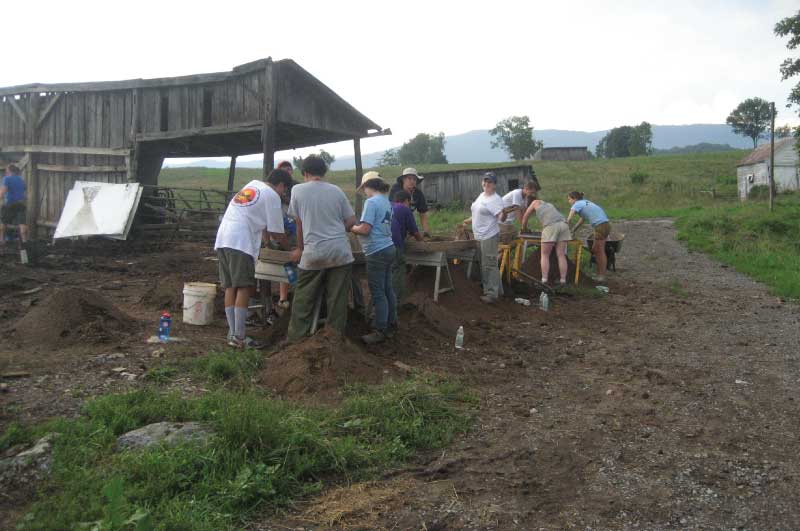|
By Danielle LaPresta Everyone in southern West Virginia knows about the 2013 National Boy Scouts Jamboree. Two weeks ago, thousands of scouts (estimates up to 50,000), along with parents, siblings, and scout leaders came to southern West Virginia to complete service projects in the state. Whatever your feelings are toward the Boy Scout organization, you must agree this is a very impressive planning feat. The Whipple Company Store in Scarbro and McCoy Fort in Williamsburg are two sites on the West Virginia Endangered Properties List that engaged the scouts for service projects. Sites had to complete a vigorous application process to receive this support, but it seems well worth the efforts! The archaeological work at McCoy Fort progressed greatly with the help of the scouts, Appalachian Forest Heritage Area AmeriCorps members, and other volunteers, including professional archaeologists Dr. Kim and Dr. Stephen McBride and Carolyn Stephens. It must be mentioned that Carolyn has been working tirelessly to pull off this event, and she did so almost single-handedly. She personifies what we mean when we say this is a grassroots project. A little background on the fort… The fort and archaeological site had been covered by a sheep barn at least a century ago. This barn protected the fort and site from the elements, but in the last few years, weather ravaged the barn and threatened the fort and site. With the barn collapsing, Carolyn and several other volunteers were faced with the question of how to dismantle the barn safely and not damage the fort in time for the scouts’ scheduled archaeology project. The fort is located about 15 miles from Route 219, a major artery traveling through rural Greenbrier and Pocahontas Counties. Starting off with two lanes, the road to McCoy Fort quickly narrows to one lane through the lush farmland of Williamsburg. It is a tough road to travel with heavy machinery, which is needed to dismantle the barn and the fort, although I saw plenty of WV Department of Transportation Trucks during my commute on the country road. Many contractors did not want to take on the job because it was small and in a rural location. They did not see it as a cost effective project for either side. Carolyn had been at a loss for some time over dismantling the fort. She had lots of support from the state, county, and community, as well as the National Trust for Historic Preservation, which provided emergency funding to preserve the site and fort after the 2012 derecho. However, she could not find anyone to dismantle the barn and the fort so that an archaeological excavation could occur. McCoy Fort tagged and dismantled in preparation for the archaeology, which is needed to complete the National Register Nomination.
About a week before the scouts arrived, Carolyn, her husband, and several volunteers cleaned up the site and barn debris, tagged the fort logs, and dismantled and moved the logs. It was a remarkable feat! And just in time for the scouts to participate in the archaeological dig. When I stopped by the site last Thursday to see the scouts working, I was truly awe-struck and inspired by what a few people can accomplish in preparation for a larger project. The scouts were thoroughly involved and seemed genuinely excited about their work, even if it was covered somewhat in sheep manure. Dr. Kim McBride was thrilled about the day’s finds, and the foundation of the fort was identified. Although it is not confirmed if the site was definitely a fort, archaeologists are on their way to interpreting it and educating us all about a lesser-known frontier historical site in West Virginia. The McBrides and Carolyn are already planning a workshop with the community to clean the artifacts, and they are developing plans to engage 5th and 8th grade Greenbrier County students and teachers in the educational process. It is a community effort worth mirroring! Comments are closed.
|
News and NotesCategories
All
Archives
May 2024
Subscribe to our mailing list to receive e-news updates on historic preservation news and events in West Virginia.
|
Get Involved |
Programs |
Contact UsPreservation Alliance of West Virginia
421 Davis Avenue, #4 | Elkins, WV 26241 Email: [email protected] Phone: 304-345-6005 |
Organizational Partners:
© COPYRIGHT 2022 - PRESERVATION ALLIANCE OF WEST VIRGINIA. ALL RIGHTS RESERVED.






 RSS Feed
RSS Feed



